|
|
|
| Description The Festool HL850E is a hand held planer. These machines are not typically used to plane lumber to uniform thickness as are hand planes or bench top planers but aside from that they are useful for just about any other situation one would use a hand plane and they are capable of far rougher work as well. As with most Festool offerings the HL850E is basically the top end of this type of tool. The unit is somewhat large for it’s working capacity which at times is beneficial as it adds a level of stability. The maximum planed width is 3.25 inches, the sole is 13.75 inches long and the maximum depth of cut is about 0.14”, the rabetting depth is basically unlimited. The motor is rated at 10k rpm and 7 amps giving it lots of power. |
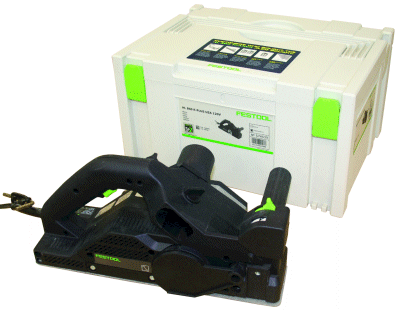 |
| The planer features a large fore motorcycle style grip and a large D type grip aft making for a very controllable machine. The depth settings are measured in metric with very fine control. The machine itself is useful for fine power work such as trimming doors, scribing, and bevel cuts. It is also capable of rough and finish carpentry in addition to some other unique uses. There are accessories that transform the machine; among these are replaceable heads to allow profiles besides the standard straight cut as well as a stand that allows the machine to be used as a mini bench top jointer. | |
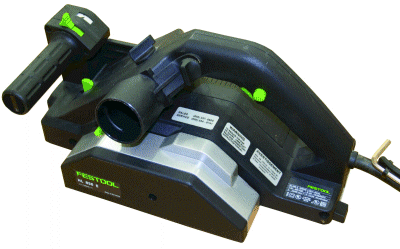
|
In Use Although I initially I used the machine for rough carpentry, for the most part I’ll describe the machine and its use in a woodworking shop and for finish carpentry. Ergonomically the machine provides very good integration to the operator with it’s two grip design. The machine is too heavy for much one handed or overhead use but two handed, it’s very controllable. The sole length and grip combine to allow the operator to take very controlled and snipe free cuts. The operator controls are very well placed and allow the operator to use them without releasing the handles. The fore motorcycle grip allows for easy depth adjustments even on the fly. On the fly adjustment is handy for scribing work and such. A depth scale is marked off in 0.1mm increments. |
| The standard flat cut head is a single blade spiral design. The spiral head cutter is uncommon on these machines and it provides a much smoother cut devoid of chatter marks common to the standard straight bladed machines. The spiral cutter head also takes less force to move through a cut and is a probably a bit quieter too. The knives themselves are easily replaceable with no calibration required. The fore handle stores a small wrench used to loosen and tighten the blades. The blades themselves are not too expensive and easy enough to replace, one might choose to have a rough and fine set on hand. | 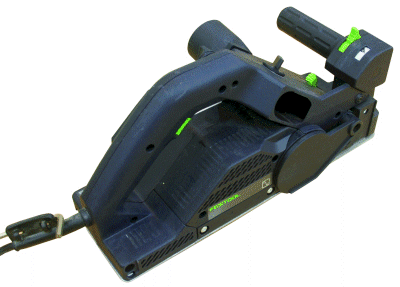 |
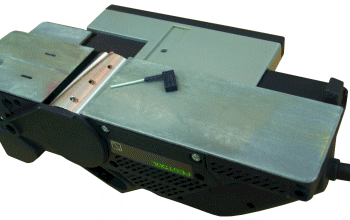 |
Planers are somewhat dangerous tools due to the exposed cutter
heads. The HL850E Planer has a spring loaded
foot on the aft end of the sole which keeps the cutter head from hitting a flat surface
when the tool is set down. This also helps
to keep the blade from getting accidentally nicked too. This view shows the single groove in the sole that can be used to reference bevel or chamfering cuts as well as the screw hole for attaching the three different fence accessories. |
Many planers have a chip exhaust port on only one side of the machine, that basically means it’s on the wrong side half of the time. The HL850E allows chips to exit either left or right via a deflector controlled by a knob on the top of the machine. Dust collection is very good with the machine. The typical 27mm Festool hose does not fit the port well, the larger 36mm hose should be used. Even with a 27mm hose connected to my CT22, chip collection was very good. This machine can generate a lot of chips, the larger 36mm hose is what I would recommend. The long cord works well with the Festool vacuum but it is not a Plug-It type design. In rough work, dust collection isn’t a big deal, you might not even bother. In finish trim work and remodels it can be a very big deal and as usual, that’s where the Festool dust collection performance always shines through. A machine like this can create a lot of chips and it has the power to throw them far. For a professional, the time savings on cleanup alone could quickly pay for the tool. |
| Accessories Along with the basic machine I also evaluated the three special cutter heads, the Bench Unit (stand), and the Angle Stop (big fence). Starting with the special cutter heads, these are primarily used for creating a rustic effect on new wood to make them appear more hand worked. These fall into what I’ll call a single wave, course wave, and fine wave pattern. With these it would be a piece of cake to create trim pieces that can be fabricated on the ground or even in the shop. Attach these to sleepers on site and you’ve got yourself some instant “hand” hewn beams. These are almost too easy and quick to make. The single wave cutter can also be used exactly the same as a scrub hand plane to hog off material. The open end design of the cutter head makes for an easy head change. |
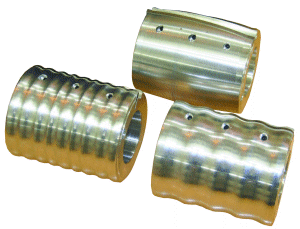 |
| The Bench Unit is just a few brackets on a base used to hold the planer upside down so it can be used as a mini jointer. Since the trigger has an interlock instead of a lock, included with this kit is a plastic wedge device to keep the trigger on. This seems a little hokey at first but if you think about it, it is faster easier to cut power pulling this wedge out than it would be to get to the trigger. The base of the stand includes slots to allow the use of the Festool style clamps but the bottom of the base has rubber strips applied so for small work you may not even need to clamp the unit down (although for safety reason it would be good to do so). | 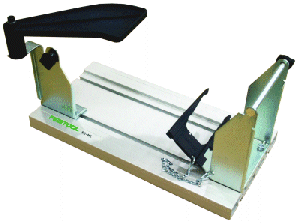 |
| The Bench Unit includes a small plastic North American style
cutter head guard. The maximum practical
length of a board than can be jointed is around 3 feet or so. As shown here, the Angle Stop or “big fence” is a natural addition to the Bench Unit. Festool has a smaller and much cheaper fence system but really, this is the one you want even if you don’t have the Bench Unit. The fence attaches via a single captured screw to the machine underside and is very generous in size, the cheaper fence is more of an edge guide by comparison. The big fence allows for angled settings as well. |
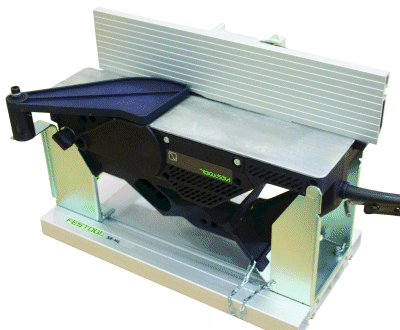 |
|
In the interest of full disclosure Festool provided this product to facilitate this review.
|